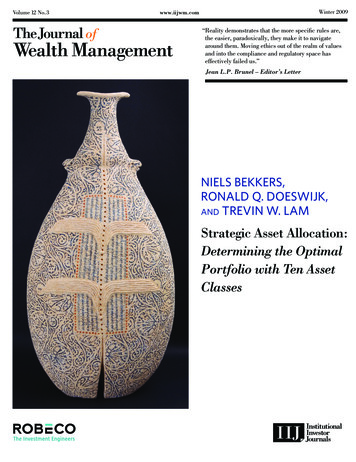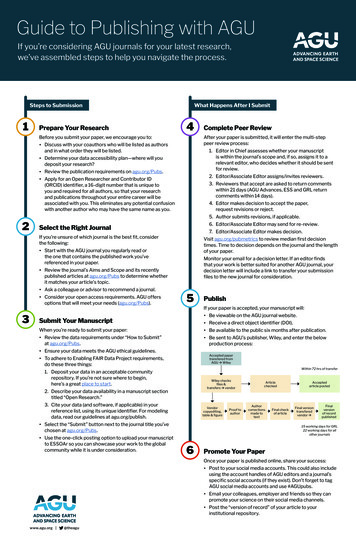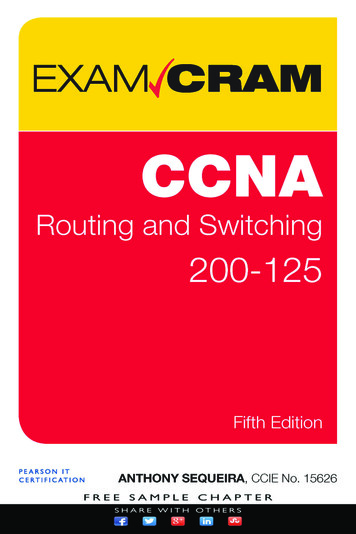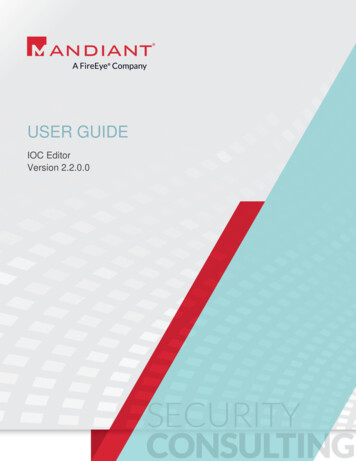
Transcription
Volume 12 No. 3Winter 2009www.iijwm.com“Reality demonstrates that the more specific rules are,the easier, paradoxically, they make it to navigatearound them. Moving ethics out of the realm of valuesand into the compliance and regulatory space haseffectively failed us.”Jean L.P. Brunel – Editor’s LetterNIELS BEKKERS,RONALD Q. DOESWIJK,and TREVIN W. LAMStrategic Asset Allocation:Determining the OptimalPortfolio with Ten AssetClasses
Robeco is an international asset manager offering an extensive range of active investments,from equities to bonds. Research lies at the heart of everything we do, with a ‘pioneering butcautious’ approach that has been in our DNA since our foundation in Rotterdam in 1929. Webelieve strongly in sustainability investing, quantitative techniques and constant innovation.
JWM-BEKKERS:Layout 110/20/093:21 AMPage 61Strategic Asset Allocation:Determining the OptimalPortfolio with Ten Asset ClassesNIELS BEKKERS, RONALD Q. DOESWIJK, AND TREVIN W. LAMNIELS BEKKERScurrently is a business analyst at Mars in Veghel, TheNetherlands. During hiswork for this article heobtained a master degree ineconomics at Tilburg University, The Netherlands.niels.bekkers@eu.effem.comRONALD Q. DOESWIJKis a vice president andstrategist at Robecoin Rotterdam,The Netherlands.r.doeswijk@robeco.nlTREVIN W. LAMis a quantitative analyst atRabobank in Utrecht,The Netherlands.t.w.lam@rn.rabobank.nlWINTER 2009ost previous academic studiesagree on the importance ofstrategic asset allocation as adeterminant for investmentreturns. In their frequently cited paper, Brinson,Hood, and Beebower [1986] claim that 93.6%of performance variation can be explained bystrategic asset allocation decisions. This resultimplies that strategic asset allocation is far moreimportant than market timing and securityselection.Most asset allocation studies focus on theimplications of adding one or two asset classesto a traditional asset mix of stocks, bonds, andcash to conclude whether and to what extentan asset class should be included to the strategicportfolio; see for example Erb and Harvey[2006] and Lamm [1998]. However, since assetclasses were omitted, this partial analysis canlead to sub-optimal portfolios. This is surprising, as pension funds and other institutions have been strategically shifting substantialparts of their investment portfolios towardsnon-traditional assets such as real estate, commodities, hedge funds, and private equity.The goal of this article is to explore whichasset classes add value to a traditional asset mixand to determine the optimal weights of all assetclasses in the optimal portfolio. The article addsto the literature by distinguishing 10 differentinvestment categories simultaneously in a meanvariance analysis as well as a market portfolioapproach. It also demonstrates how to combineMthese two methods. Next to the traditional threeasset classes, stocks, government bonds, and cash,we include private equity, real estate, hedgefunds, commodities, high yield, credits, and inflation-linked bonds. A study with such a broadcoverage of asset classes has not been conductedbefore, neither in the context of determiningcapital market expectations and performing amean-variance analysis, nor in assessing theglobal market portfolio. The second step in portfolio management—i.e., market timing andsecurity selection—is tactical decision making.These are beyond the scope of this article.In short, this article suggests that addingreal estate, commodities, and high yield to thetraditional asset mix delivers the most efficiency, improving value for investors. Next, itshows that the proportion of non-traditionalasset classes appearing in the market portfoliois relatively small. The article then reports anempirical and literature analysis to establishlong-run capital market expectations for eachasset class, which we subsequently use in amean-variance analysis. Then, we provide anassessment of the global market portfolio.Finally, we show how the mean-variance andmarket portfolio approaches can be combinedto determine optimal portfolios.METHODOLOGYMarkowitz [1952, 1956] pioneered thedevelopment of a quantitative method that takesTHE JOURNAL OF WEALTH MANAGEMENT1
JWM-BEKKERS:Layout 110/20/093:21 AMPage 62into account the diversification benefits of portfolio allocation. Modern portfolio theory is the result of his workon portfolio optimization. Ideally, in a mean-variance optimization model, the complete investment opportunityset—i.e., all assets—should be considered simultaneously.However, in practice, most investors distinguish betweendifferent asset classes within their portfolio-allocationframeworks. This two-stage model is generally applied byinstitutional investors, resulting in a top-down allocationstrategy.The first part of our analysis views the process ofasset allocation as a four-step exercise, as in Bodie, Kane,and Marcus [2005]. It consists of choosing the asset classesunder consideration, then moving forward to establishingcapital market expectations, followed by deriving the efficient frontier until finding the optimal asset mix. In thesecond part of our analysis, we assess the global marketportfolio. Finally, we show how the mean-variance andmarket-neutral portfolio approaches can be combined todetermine optimal portfolios.We take the perspective of an asset-only investor insearch of the optimal portfolio. An asset-only investordoes not take liabilities into account. The investmenthorizon is one year and the opportunity set consists of10 asset classes. The investor pursues wealth maximization,and no other particular investment goals are considered.We solve the asset-allocation problem using a meanvariance optimization based on excess returns. The goalis to maximize the Sharpe ratio (risk-adjusted return) ofthe portfolio, bounded by the restriction that the exposure to any risky asset class is greater than or equal to zeroand that the sum of the weights adds up to one. The focusis on the relative allocation to risky assets in the optimalportfolio, instead of the allocation to cash. The weight ofcash is a function of the investor’s level of risk aversion.For the expected risk premia we use geometricreturns with intervals of 0.25%. The interval for the standard deviations is 1%, and for correlations it is 0.1. In ouropinion, more precise estimates might have an appearance of exactness, which we want to prevent. We do nottake management fees into consideration, except for private equity and hedge funds, as for these asset classes themanagement fees are rather high relative to the expectedrisk premia. Other asset classes have significantly lowerfees compared to their risk premia. They are therefore ofminor importance, especially after taking into account theuncertainty of our estimates. We estimate risk premiumsby subtracting geometric returns from one another.2Hereby, our estimated geometric returns as well as therisk premiums are both round numbers.In the mean-variance analysis, we use arithmeticexcess returns. Geometric returns are not suitable in amean-variance framework. The weighted average of geometric returns does not equal the geometric return of asimulated portfolio with the same composition. Theobserved difference can be explained by the diversification benefits of the portfolio allocation. We derive thearithmetic returns from the geometric returns and thevolatility.DATAWe focus primarily on U.S. data in the empiricalanalysis. This choice is backed by two arguments. First, theU.S. market offers the longest data series among almostall asset classes. This makes a historical comparison moremeaningful. For instance, the high-yield bond market haslong been solely a U.S. capital market phenomenon. Secondly, using U.S. data avoids the geographical mismatchin global data. A global index for the relatively new assetclass of inflation-linked bonds is biased towards the U.S.,French, and U.K. markets, while a global stock index isdecently spread over numerous countries. We use totalreturn indices in U.S. dollars.Asset classes like real estate and private equity arerepresented in both listed and non-listed indices, whilehedge funds are covered only by non-listed indices. Nonlisted real estate and private equity indices are appraisalbased, which may cause a smoothing effect in the assumedrisk of the asset class. This bias arises because the appraisalsdo not take place frequently. However, interpolatingreturns causes an underestimation of risk. Also, changes inprices are not immediately reflected in appraisal valuesuntil there is sufficient evidence for an adjustment. Statistical procedures to mitigate these data problems exist,but there is no guarantee that these methods produceaccurate measures of true holding-period returns; seeFroot [1995]. As these smoothing effects can lead to anunderestimation of risk, this article avoids non-listeddatasets and instead adopts listed indices for real estate andprivate equity. The quality of return data of listed indicesis assumed to be higher, as they are based on transactionprices. Ibbotson [2006] supports this approach and states,“Although all investors may not yet agree that direct commercial real estate investments and indirect commercialreal investments (REITs) provide the same risk-rewardSTRATEGIC ASSET ALLOCATION: DETERMINING THE OPTIMAL PORTFOLIO WITH TEN ASSET CLASSESWINTER 2009
JWM-BEKKERS:Layout 110/20/093:21 AMPage 63exposure to commercial real estate, a growing body ofresearch indicates that investment returns from the twomarkets are either the same or nearly so.” For hedge fundswe will use a fund-of-funds index that we unsmooth withGeltner [1991, 1993] techniques. Fung and Hsieh [2000]describe the important role of funds of hedge funds as aproxy for the market portfolio of hedge funds.Appendices A and B contain our data sources. InAppendix A we discuss our capital market expectations,and in Appendix B we derive the market portfolio froma variety of data sources.EMPIRICAL RESULTSCapital Market ExpectationsWe estimate risk premia for all asset classes based onprevious reported studies, our own empirical analyses ofdata series, and the basic idea that risk should be rewarded.Obviously, estimates like these inevitably are subjective asthe academic literature provides only limited studies intothe statistical characteristics of asset classes. Moreover, thereis generally no consensus among academics and we lacklong-term data for most asset classes. Our results shouldtherefore be treated with care, especially since meanvariance analysis is known for its corner solutions, beinghighly sensitive in terms of its input parameters.This article proceeds with the risk premia and standard deviations as shown in Exhibit 1. Appendix A contains the reasoning for these estimates and for thecorrelation matrix.Mean-Variance AnalysisExhibit 2 shows the optimal portfolio based on themean-variance analysis and its descriptive statistics for atraditional portfolio with stocks and bonds as well as aportfolio with all assets. On top of the traditional assetclasses of stocks and bonds, this analysis suggests that it isattractive for an investor to add real estate, commodities,and high yield. The Sharpe ratio increases from 0.346 to0.396. The allocation to real estate is quite high. To bringthis into perspective, we suggest that the proposed portfolio weight is overdone. When one would, for example,be willing to perceive utilities as a separate asset class, it islikely that it also would get a significant allocation as thissector also has a low correlation to the general stock market.Exhibit 2 also illustrates that mean-variance analysistends towards corner solutions as it neglects credits, whichhave characteristics comparable with bonds. However,with these parameters it prefers bonds in the optimalportfolio.Exhibit 3 shows the benefits of diversification intonon-traditional asset classes. In the volatility range of 7%to 20%, the diversification benefits vary between 0.40%and 0.93%. This additional return is economically significant. For example, at a volatility of 10%, the additionalreturn is 0.56%. The efficient frontier of a portfolio withstocks, bonds, and the three asset classes, real estate, commodities, and high yield, comes close to the efficient frontier of an all-asset portfolio. By adding these three assetclasses, an investor almost captures the complete diversification benefit.EXHIBIT 1Overview of Capital Market Expectations for all Asset ClassesNote: *We derive arithmetic data by using the equation RA RG 0.5 variance.WINTER 2009THE JOURNAL OF WEALTH MANAGEMENT3
JWM-BEKKERS:Layout 110/20/093:21 AMPage 64EXHIBIT 2Optimal Portfolio for a Traditional Portfolio and for an All-Assets PortfolioEXHIBIT 3Efficient Frontier for Different Portfolios4STRATEGIC ASSET ALLOCATION: DETERMINING THE OPTIMAL PORTFOLIO WITH TEN ASSET CLASSESWINTER 2009
JWM-BEKKERS:Layout 110/20/093:21 AMPage 65For various reasons, not all investors use cash to(un)leverage their investment portfolio. Therefore, it isinteresting to observe the composition of efficient portfolios in a world without the risk-free rate. Exhibit 4 showsthe asset allocation on the efficient frontier in an all-assetportfolio starting from a minimum variance allocationtowards a risky portfolio. It maximizes the expected excessreturn constrained by a given volatility.In the least risky asset allocation, an investor allocates77.7% of the portfolio towards fixed-income assets. Nextto bonds and stocks, real estate and commodities receivea significant allocation in portfolios with a volatility inthe range of 7.5% to 12.5%. High yield is also present inmost of the portfolios in this range. For riskier portfolios,private equity shows up, and in the end, it ousts bonds,real estate, commodities, and stocks (in that order). Fordefensive investors, inflation-linked bonds and hedge fundsenter the portfolio.In short, the mean-variance analysis suggests thatadding real estate, commodities, and high yield to thetraditional asset mix of stocks and bonds creates the mostvalue for investors. Basically, adding these three assetclasses comes close to an all-asset portfolio. Private equityis somewhat similar to stocks, but shows up in riskierportfolios, moving along the efficient frontier. This partof the efficient frontier is interesting for investors insearch of high returns without leveraging the marketportfolio. Hedge funds as a group do not add value. Obviously, when investors attribute alpha to a particular hedgefund, it changes the case for that fund. This also appliesto private equity. Credits and bonds are quite similar assetclasses, and in a mean-variance context the optimal portfolio tends to tilt to one or another. Inflation-linkedbonds do not show up in our mean-variance analysis.The inflation risk premium and the high correlationwith bonds prevent an allocation towards this asset classin that setting. However, for defensive investors who primarily seek protection against inflation, this asset classcan be very interesting.EXHIBIT 4Asset Allocation on the Efficient Frontier in an All-Assets PortfolioWINTER 2009THE JOURNAL OF WEALTH MANAGEMENT5
JWM-BEKKERS:Layout 110/20/093:21 AMPage 66Market PortfolioBoth academics and practitioners agree that themean-variance analysis is extremely sensitive to smallchanges and errors in the assumptions. We therefore takeanother approach to the asset allocation problem, in whichwe estimate the weights of the asset classes in the marketportfolio. The composition of the observed market portfolio embodies the aggregate return, risk, and correlationexpectations of all market participants and is by definitionthe optimal portfolio. In practice, however, borrowing isrestricted for most investors and at the same time borrowingrates usually exceed lending rates. The result is that themarket portfolio is possibly no longer the common optimalportfolio for all investors, because some might choose riskyportfolios on the efficient frontier beyond the point whereno money is allocated to the risk-free rate. In addition, aninvestor’s specific situation could also lead to a differentportfolio. Despite this limitation, the relative market capitalization of asset classes provides valuable guidance for theasset allocation problem. In this setting, the market-neutralweight for a particular asset class is its market value relativeto the world’s total market value of all asset classes.Exhibit 5 shows the global market portfolio basedon a variety of data sources. Appendix B provides detailsabout the market portfolio and its dynamics for the period2006–2008. The asset classes stocks and investment gradebonds (government bonds and credits) represent morethan 85% of the market for these years. At the end of 2008we estimate this number at 88.8%. This means that the sizeof the average remaining asset class is less than 12.0%.Based on this analysis, we conclude that the proportionof non-traditional asset classes appearing in the marketportfolio is relatively small.Combination of Market Portfolioand Mean-Variance AnalysisThe mean-variance analysis can be combined withthe market portfolio. Here, we choose to take the marketportfolio as a starting point, which we subsequently optimize with turnover and tracking error constraints. Wechoose to take the market portfolio as a starting point, as itembodies the aggregate return, risk, and correlation expectations of all market participants without the disadvantageEXHIBIT 5Pie Chart of the Market Portfolio at the End of 20086STRATEGIC ASSET ALLOCATION: DETERMINING THE OPTIMAL PORTFOLIO WITH TEN ASSET CLASSESWINTER 2009
JWM-BEKKERS:Layout 110/20/093:21 AMPage 67of delivering the corner solutions of the mean-varianceanalysis.Exhibit 6 shows the optimal portfolios with different tracking error constraints and a maximumturnover of 25% (single count) relative to the marketportfolio. In other words, in this example we limit ourselves to finding optimized portfolios with portfolioweights that do not differ more than 25% from themarket portfolio, calculated as the sum of the absolutedifference between the market portfolio and the optimized portfolio for each asset class. Focusing on the0.25% tracking error constraint, it appears that theanalysis recommends especially adding real estate, commodities, and high yield, and removing hedge funds andinflation-linked bonds. This is logical, as the results fromthe mean-variance analysis are applied in this marketportfolio-adjustment process. There is a 12.5% shift inportfolio weights. Obviously, fewer constraints result ina higher risk premium and a higher Sharpe ratio, untilwe end up with the theoretically optimal portfolio fromthe mean-variance analysis. Within this methodology,investors must determine their own individual constraints, while the market portfolio and the portfoliooptimized by mean-variance are considered as theboundaries for the asset classes.SUMMARY AND CONCLUSIONSOur mean-variance analysis suggests that real estate,commodities, and high yield add the most value to thetraditional asset mix of stocks, bonds, and cash. Basically,adding these three asset classes comes close to an all-assetportfolio. The portfolio with all assets shows a diversification benefit along the efficient frontier that varies between0.40% and 0.93% in the volatility range of 7% to 20%.That is an economically significant extra return for free.Another approach to the asset allocation problem isassessing the weights of the asset classes in the marketportfolio. Based on this analysis we conclude that the proportion of non-traditional asset classes appearing in themarket portfolio is relatively small.One can combine the mean-variance analysis withthe market portfolio. Within this methodology, investorsmust determine their own individual constraints, whilethe market portfolio and the portfolio optimized by meanvariance are considered as the boundaries for the assetclasses.EXHIBIT 6Optimal Portfolio for Different Tracking Error Constraints and a Maximum Turnover Constraint of 25% (SingleCount), and the No Contraints Optimal Portfolio That Represents the Results of the Mean-Variance AnalysisWINTER 2009THE JOURNAL OF WEALTH MANAGEMENT7
JWM-BEKKERS:Layout 110/20/093:21 AMPage 68APPENDIX ACapital Market ExpectationsRisk premia for stocks and bonds are well documented,and long-term data series extending over 100 years are available. We will therefore start with the risk premia for stocks andbonds. Then, we derive the risk premia of other asset classes bycomparing historical performance data and consulting the literature. In order to estimate volatilities and correlations, we relymore on our own historical data, due to a lack of broad coverage in the literature. Below, we discuss returns and standarddeviations for each asset class. Afterwards, we estimate correlations among all asset classes.Stocks. Extensive research on the equity-risk premiumhas been conducted in recent years. Fama and French [2002]use a dividend discount model to estimate an arithmetic riskpremium of 3.54% over the period 1872–2000 for U.S. stocks,while the realized risk premium for this period is 5.57%. In theperiod 1951–2000, the observed difference is even larger. Theyconclude that the high 1951–2000 returns are the result of lowexpected future performance. However, the United States wasone of the most successful stock markets in the 20th century,so a global perspective is important to correct this bias. Dimson,Marsh, and Staunton [2009] use historical equity risk premiafor 17 countries over the period 1900–2008. They conclude thattheir equity risk premia are lower than frequently cited in theliterature, due to a longer timeframe and a global perspective.Exhibit A1 provides an overview of historical risk premia andvolatilities.Both Fama and French [2002] and Dimson, Marsh, andStaunton [2003, 2009] find that the historical equity premiumwas significantly higher in the second half of the 20th centurythan it was in the first half. Dimson, Marsh, and Staunton [2009]expect a lower equity premium in the range of 3.0% to 3.5%going forward. In this article we use an equity risk premium of4.75%. This is slightly above the average of countries in a longtimeframe and corresponds well with consensus estimates amongfinance professors as documented by Welch [2008] and amongCFOs as reported by Graham & Harvey [2008].The other estimate we need is stock market volatility.Dimson, Marsh, and Staunton [2009] find a standard deviationof 17.3% for global equity during the 109-year period1900–2008. Over the period 1970–2008 the global MSCI index1had a volatility of 18.8% and 22.0% expressed in dollars andeuros, respectively. We average these last two figures and estimate the volatility of stocks at 20%.Government bonds. Dimson, Marsh, and Staunton [2009]also evaluate the risk premium of bonds over cash. Their datapoint to a lower risk premium than the Barclays GovernmentIndices, which have been available since 1973; see Exhibit A2.The last decades have been extremely good for governmentbonds. We use a geometric risk premium of 0.75% for government bonds over cash, in line with the long-term historicalaverage from Dimson, Marsh, and Staunton [2009].The volatility of bonds has been significantly lower inrecent decades compared to longer timeframes, as Exhibit A2shows. Over the last 25 years and the last 10 years, it has comedown to 6.3% and 5.5%, respectively. We think a volatility ofEXHIBIT A1Overview of Historical Risk and Return Characteristics for StocksNote: *Standard deviation of the risk premium instead of the standard deviation of the nominal return. We derive geometric data by using the equationRG RA – 0.5 variance.8STRATEGIC ASSET ALLOCATION: DETERMINING THE OPTIMAL PORTFOLIO WITH TEN ASSET CLASSESWINTER 2009
JWM-BEKKERS:Layout 110/20/093:21 AMPage 69EXHIBIT A2Overview of Historical Risk and Return Characteristics for Government Bonds7% is the best proxy for government bonds. This accounts forthe inflation-targeting monetary policy introduced by majorcentral banks in the early 1980s, while it is in line with theobserved volatility in the last decades.Private equity. For private equity one could expect a riskpremium relative to stocks due to low liquidity. Willshire [2008]estimates the risk premium for private equity over stocks at 3%using a combination of each U.S. retirement system’s actual assetallocation and its own assumptions; see Exhibit A3.Kaplan and Schoar [2005] find average returns equal tothat of the S&P 500, but they did not correct for sample biases.Using 1,328 mature private equity funds, Phalippou andGottschalg [2007] conclude that performance estimates found inprevious research overstate actual returns. They find an underperformance of 3% compared to the S&P 500 (net of fees). In aliterature overview, Phalippou [2007] finds support to Swensen’s[2000] claims that private equity generates poor returns and thatthe low risk observed is the result of a statistical artefact.We use LPX indices that represent listed private equity.Survivorship bias is assumed to be negligible, since the indextakes into account that companies are bought or merged, changetheir business model, or are delisted. Our data also show anunderperformance, but this concerns a short sample period.Since we do not have enough support from existing literaturethat private equity returns (net of fees) exceed public equityreturns, we assume the risk premia of stocks and private equityto be equal to 4.75%.Historical returns show private equity had more risk thanstocks, and other research find a beta for private equity greaterthan one; see Phalippou [2007]. Based on annual standard deviations we should adopt standard deviations for private equitythat are almost twice the standard deviations of stocks. However, because our data history is short, we focus on annualizedstandard deviations of monthly returns. Then, averaged overthe United States and Europe, the standard deviation is 50%higher for private equity than for stocks. Therefore, we estimate the volatility of private equity at 30%.Real estate. Of all alternative asset classes, real estate probably received most attention from academics in the past. A literature review by Norman, Sirmans, and Benjamin [1995] triesto summarize all findings. Overall, they find no consensus forrisk and return characteristics for real estate. However, moreEXHIBIT A3Overview of Historical Risk and Return Characteristics for Private EquityWINTER 2009THE JOURNAL OF WEALTH MANAGEMENT9
JWM-BEKKERS:Layout 110/20/093:21 AMPage 70than half of the consulted literature in their paper reported alower return for real estate compared to stock.Exhibit A4 reports an overview of real estate risk andreturn characteristics. Wilshire [2008] and Fugazza, Guidolin,and Nicodano [2006] also show lower risk premia for real estatethan for stocks. We proceed with a risk premium of 3.75% relative to cash, which is 1% lower than our estimate for stocks.Compared to the long-run U.S. history, our estimate seemsrather low; but compared to Wilshire [2008], it seems high. Itis in line with Fugazza et al. [2006].Norman, Sirmans, and Benjamin [1995] conclude thatmost studies found risk-adjusted returns for real estate that arecomparable to stocks. We take this into account and estimatethe volatility of real estate at 16%, whereby ex-ante Sharpe ratiosare roughly the same for stocks and real estate, while the ratioof the standard deviations is in line with Fugazza et al. [2006].Hedge funds. The academic literature reports extensiveinformation on biases in hedge fund indices, as shown inExhibit A5. However, estimates for the market portfolio ofhedge funds are scarce. Funds of hedge funds are often considered to be a good proxy for the market portfolio, since theyhave fewer biases than typical hedge funds. However, theirreturns are affected by the double counting of managementfees. Fung and Hsieh [2000] estimate the portfolio management costs for a typical hedge fund of funds portfolio to bebetween 1.3% and 2.9%.Exhibit A6 reports historical risk premia for hedge fundsof funds. We use the HFRI fund of funds composite index,which is equally weighted and includes over 800 funds. Furthermore, it is broadly diversified across different hedge fundstyles. As McKinsey [2007] suggests, we find a weakening performance of hedge funds over cash. When we average the aggressive and conservative estimate of the risk premium over cash,we find a risk premium of roughly 1.25%. This is the estimatethat we use in this article.Over the period 1990–2008, the volatility of hedge fundswas slightly higher than half the volatility of stocks. Taking intoaccount our estimate of the volatility for stocks of 20%, we estimate the volatility of hedge funds at 12%—i.e., 11.9%/20.5%multiplied by 20%.Commodities. An unleveraged investment in commodities is a fully collateralized position that has three driversof returns: the risk-free rate, the spot return, and the roll return.Erb and Harvey [2006] point out that the roll return has beena very important driver of commodity returns, but it is unclearwhat the sign of roll returns will be in the future.2 In theirextensive study they find that the average individual compound excess return of commodity futures was zero. Theyargue that individual commodities are not homogeneous andthat their high volatility and low mutual correlations result inhigh diversification benefits. The diversification benefit comesfrom periodically rebalancing the portfolio and is reflected inthe high historical performance of the GSCI index comparedto the return from individual commodities, as can be seen inExhibit A7. We use the GSCI index, since it represents themajority of open interest in the future market (Masters [2008])EXHIBIT A4Overview of Historical Risk and Return Characteristics for Real EstateEXHIBIT A5Biases in Hedge Fund Indices10STRATE
tends towards corner solutions as it neglects credits, which have characteristics comparable with bonds. However, with these parameters it prefers bonds in the optimal portfolio. Exhibit 3 shows the benefits of diversification into non-traditional asset classes. In the volatility range of 7% to 20%, the diversification benefits vary between 0. .










